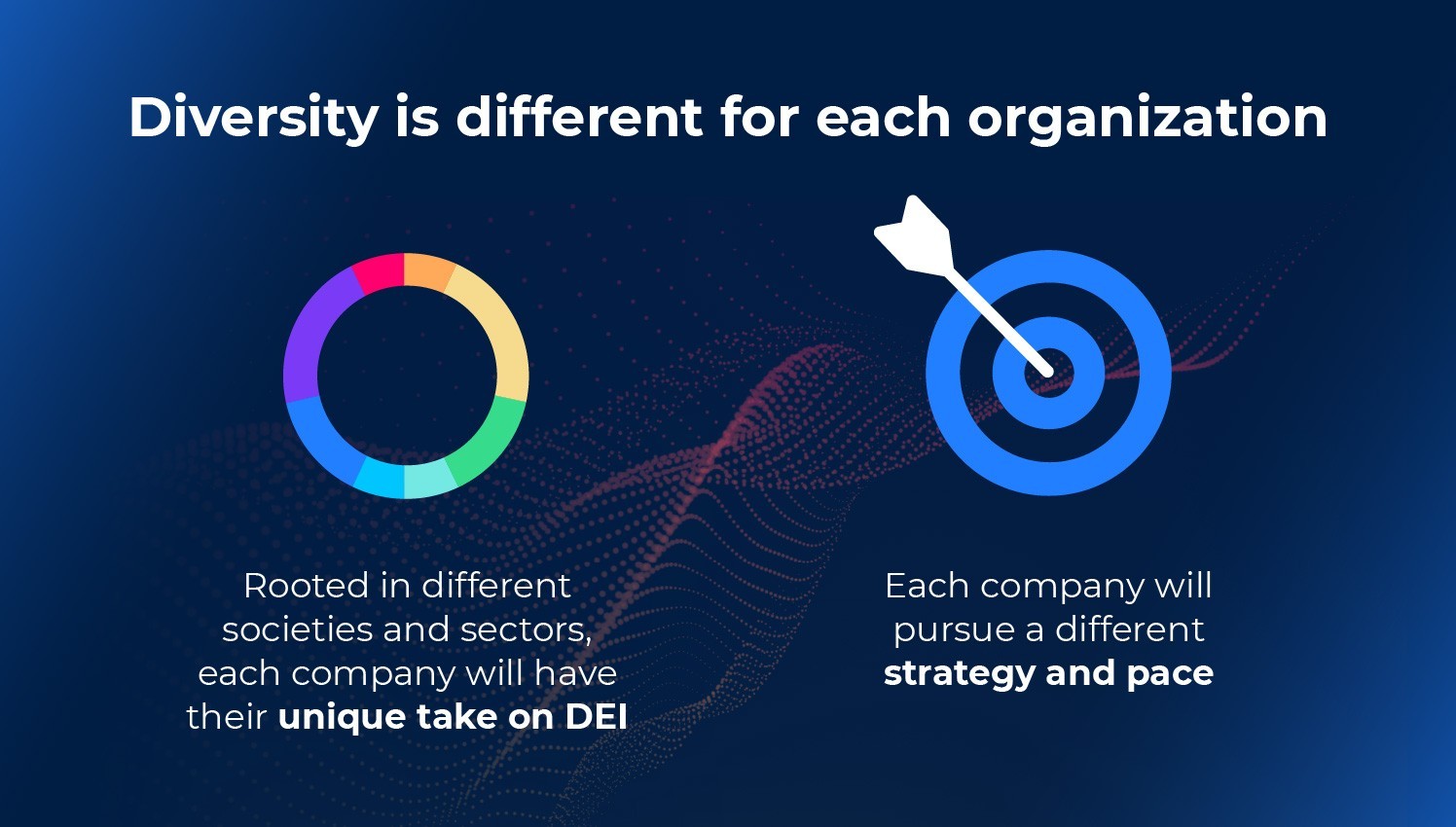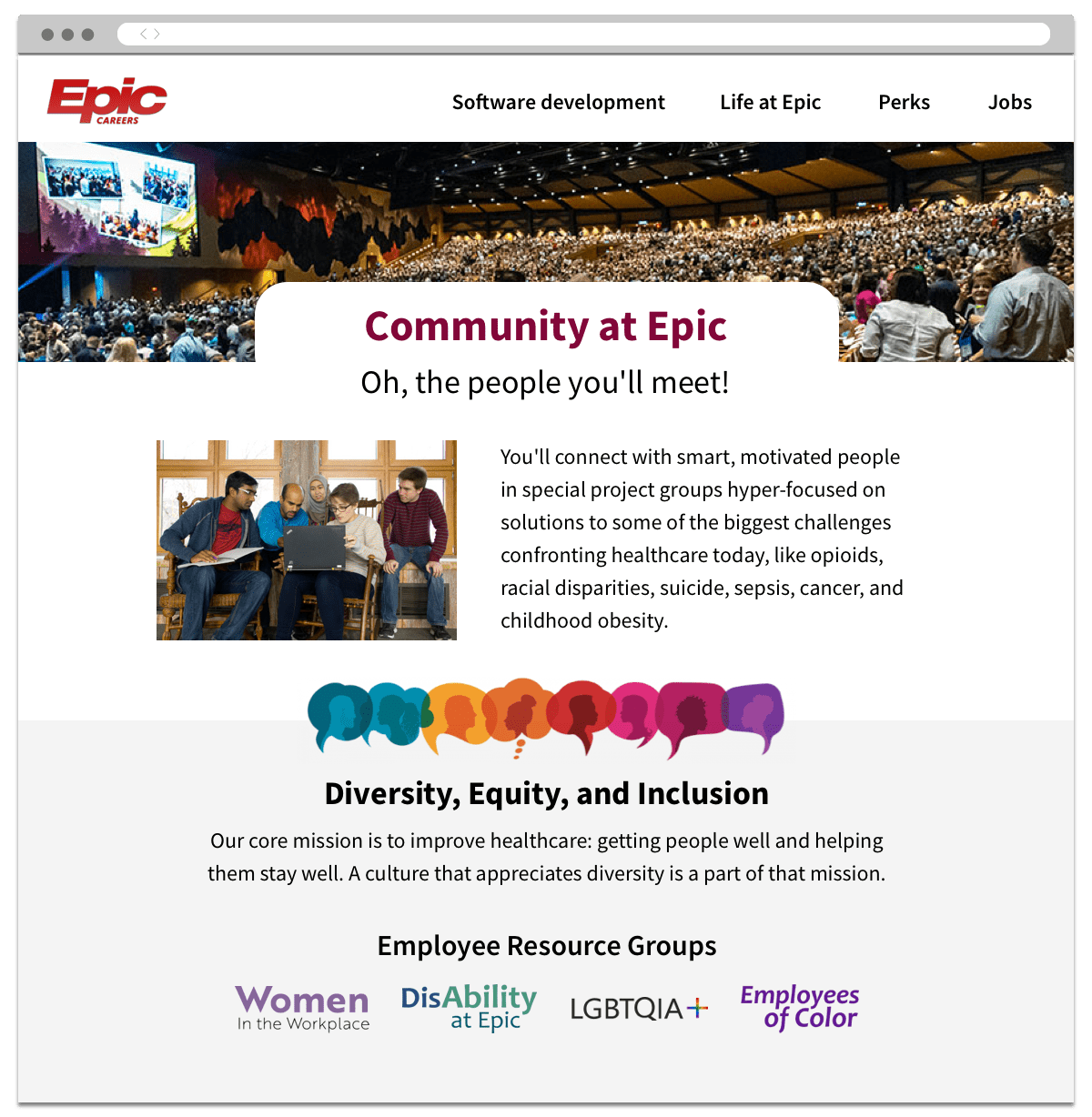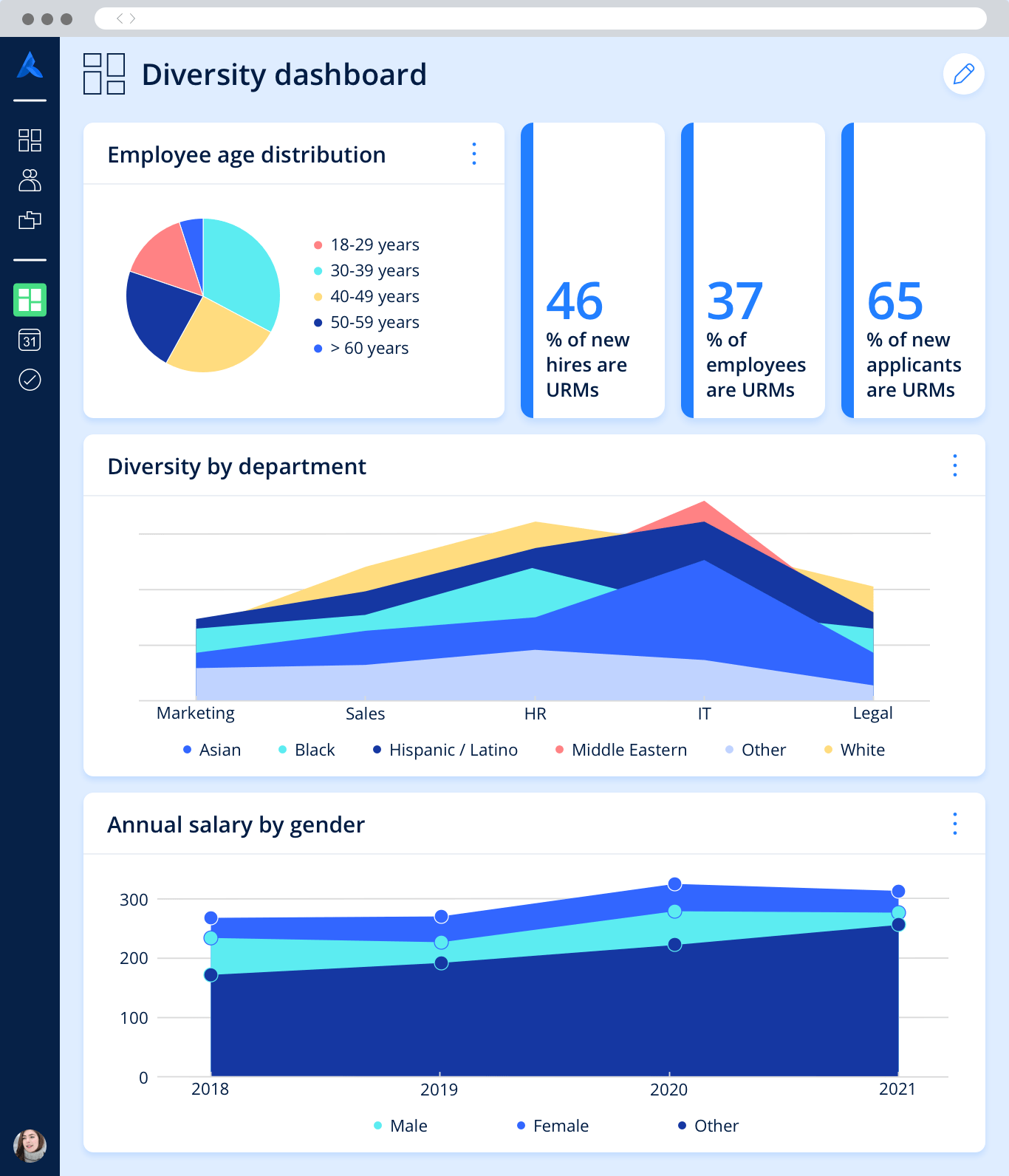While some organizations successfully deploy DEI efforts, an overwhelming majority want to create a DEI strategy and need a nudge or two (or six) in the right direction to leverage their existing resources. In fact, 76% of companies still have no diversity or inclusion goals.
Whether you want to take steps in the “diverse” direction or consolidate your strategies, large organizations can benefit enormously from two significant assets:
- a flexible platform to bring their plan to life
- the right partner to help each individual company design the processes that they particularly need to succeed
Working with our global client base across different industries, we’ve observed how a one-size-fits-all approach doesn’t work for their recruiting goals. Diversity is no exception, and it is essential to understand the multiple ways in which you can materialize your DEI vision.
Avature’s Product Marketing Specialist, Misha Chakrabarti and Solutions Architect, Gustavo Casazza, hosted a webinar in which they shared key insights and best practices to help organizations design, plan, execute and assess their own DEI strategy. They broke down the process of creating a DEI strategy into six steps, guiding organizations in the initial phases and serving as a checklist for others further along in fulfilling their most elaborate vision.
Read on to find out what you need to create your plan and show target candidates that you value them and their experience with your organization.

1. Identify Your Unique DEI Vision
Before you begin to make measurable progress, it’s crucial to take stock of your current processes. As Chakrabarti suggested, try to broaden your perceptions of what’s possible and ask yourself a few questions. For starters, “Where do I stand now?” to obtain an accurate benchmark. Then, focus on your vision: “What would my hiring look like in an ideal world?” and “What would I want my hiring processes to look like if there were no limitations?”.
“Ultimately, the clients who get the most out of Avature are teams who don’t want to be limited by an old or restrictive system and who want to reimagine the art of the possible to put in place their talent vision.”
Misha Chakrabarti
Product Marketing Specialist
With this in mind, consider the company’s objectives and challenges regarding DEI and all things talent. Once that is clear, the rebuilding stage can begin.
2. Work With Your Partners To Create Your DEI Strategy
Now that you have your vision for your dream DEI strategy, you must make it come true. To undertake this endeavor, you’ll need a flexible system that will let you reach for the stars. Navigate the journey with an experienced vendor who can offer guidance; an organization that will offer its expertise and work alongside you.
“It’s not only about the technology, but equally about the partnership with the technology vendor. Having Avature as a true partner that challenges and consults you as you develop and apply technology is a crucial success factor.”
Sebastian Hubert
HR Director at Siemens Energy
You can ensure a positive experience for your HR staff when you collaborate with a vendor eager to share its experience, expertise and knowledge of best practices. It is extremely beneficial to partner with an organization that understands your business challenges and opportunities and supports bringing your vision to life, while considering regional regulations and cultural contexts.
3. Adopt a Skills-based Approach
One of the latest recruiting and talent management trends can dramatically enhance your diversity hiring strategy. Focusing on skills rather than traditional indicators, such as work experience and academic achievements, will naturally diversify your talent pool and help open doors to candidates from broader backgrounds that you may have overlooked otherwise. This strategy helps reduce unconscious biases and levels the playing field.
Your hiring team also benefits from a consistent approach based on people’s skills that is easier to evaluate and standardizes interviews and subsequent assessments.
Applying the skills-based approach is only possible at scale if you have the right technology. Let’s examine a few examples:
- Revolutionizing traditional search, Recommended Candidates and WebSources are two Avature functionalities powered by AI which can help sourcers discover hidden gems within your database faster and more efficiently than ever before. The former suggests candidates with the necessary skills for different talent pipelines. The latter runs scheduled, semantic-powered searches to import qualified candidates from the open web with the skills that sourcers have identified.
- Recruiters can also promote diverse hiring by leveraging the skill-powered Recommended Candidates feature, broadening the range of talent for a requisition and allowing recruiters to reap the benefits of their database.
- Hiring managers can hone in on skills while reviewing candidates to find the right person for the position.
4. Ensure Transparency, Agency and Equity
Skills and AI are great tools that can bridge the DEI gap, but they are not the answer themselves. An inclusive hiring process should also be transparent and equitable and provide a sense of agency for all applicants. They want to feel they start the process on equal footing and have all the tools available to be a successful applicant.
One way of doing this is to provide external applicants with a one-stop-shop career marketplace. Even before they apply, you can inform those interested in your DEI initiatives about what your organization has already done. You can also create specific pages for audience segments such as veterans, women and other underrepresented groups.
You can continue leveling the playing field with advanced AI capabilities to deliver personalized job recommendations. Aside from suggestions based on browsing history, candidates can upload a resume to your career marketplace and receive openings based on skills, work experience and qualifications.
Grant further transparency and agency by allowing candidates to track the status of their application or withdraw if they wish. Individuals who don’t find the right fit but whose interest you’ve sparked can set up job alerts and join a talent community.
When it comes to your employees, offer them a clear career path based on skills and experience so they can visualize how to reach their goals in a way that is logical and fair. You can demonstrate your investment in their growth by creating a bustling talent marketplace where they can access tailored learning recommendations and upskilling opportunities, as well as see open positions.

Leveraging Skills and Promoting Diversity the Deutsche Telekom Way
A leading integrated telecommunications company with over 215,000 employees worldwide, Deutsche Telekom utilizes a skills-based approach. Deutsche Telekom puts a robust platform to work while keeping staff engaged and giving them agency over their professional development. It is intentional when personalizing the process to each individual and creating an engaging environment that generates tailored growth opportunities for its workforce.
Deutsche Telekom also shows its commitment to employees’ development by encouraging collaboration among staff members. The organization sets the stage for business leaders to sponsor other employees looking to upskill. Through two-way communication, internal candidates receive advice and guidance on the best ways to grow within the organization.
“You don’t want your talent to be sifting through a list of jobs or development opportunities. You want to give them what they need at the right place and at the right time. And Avature really enabled us to do this with its white-box approach towards algorithms.”
Pranav Chadha
Senior Technical Product Manager at Deutsche Telekom
Other organizations can also offer new opportunities to diverse talent by involving them in projects. This alternative is part of the modern approach to mobility, which entails more than vertical growth for top performers. By creating short- and long-term projects, you can allow employees to leverage their skills on the back burner. Projects can also represent a chance to upskill and open new doors internally. They can also be a test run, as candidates can get a sense of the career change they’re looking for.
Understanding whether or not your candidates feel they have agency can seem impossible for a seemingly intangible metric. One way to get real insights into this is to collect feedback.
5. Gather Stakeholders’ Feedback To Optimize Your DEI Efforts
Congrats! You’ve done the heavy lifting. You’ve come across diverse candidates and may be patting yourself on the back for having broadened your perspective on what’s possible in the talent acquisition and talent management arena.
The question is, have you collected honest, unfiltered feedback about the process from all those involved? If not, it’s time to do so as it will benefit your organization significantly.
With automated, branded surveys, you can gain insight into how your inclusivity initiatives are performing in practice and do so in a sustainable way for your teams that remains consistent with the candidate experience. You can also initiate a similar process to gather feedback from recruiters and hiring managers, who can zoom in on different stages and perspectives of the process and identify aspects to improve.
Asking for feedback lets you continue engaging with talent meaningfully, whether they made it to offer or not, so they keep your organization in mind for future career steps. As the company continues to improve its strategy and deployment, prospective candidates will also benefit from a better overall experience.
6. Report, Iterate and Improve Your DEI Strategy
In addition to gathering feedback, it’s essential to look at hard data collected throughout the process and assess the impact of your DEI initiatives. From the beginning, when you envisioned your DEI strategy and set your objectives, you also established KPIs to evaluate the outcome of your initiatives. Now’s the time for numbers to do the talking and let the data model provide trackable metrics. A collaborative vendor can also support and help you identify the data you need by retrieving it in custom reports.
A powerful, flexible platform allows your stakeholders to create specific reports and dashboards depending on their interests and audiences, giving them real-time insights to take evidence-based action. The Avature data model lets you track anything in your system and see all the data combined in a fully customizable diversity dashboard.
“I love the customization Avature provides. No matter what situation you have, there is a way to configure Avature for what you need. I also love the reporting feature that lets you take a report that captures real-time data from the system and export it to an Excel spreadsheet. The spreadsheet can be refreshed so that even non-Avature users can have real-time data. The dynamic reports are fantastic”
Undisclosed Reviewer on G2
Talent Acquisition Operations Manager
For instance, sourcers may benefit from understanding the diversity of their talent pipelines, while hiring managers may want to focus on how talent experiences the interview stage. You can also create and export reports with the metrics most important to the C-Suite, such as cost per hire, time to fill and DEI-specific ones like male/female annual salary and diversity by department.
Once you’ve spotted strengths and weaknesses, you can make informed decisions to adjust your strategy accordingly.

An Ongoing Journey
DEI can be an overwhelming topic, but ignoring it or implementing a generic plan won’t do your organization any favors. What you can do is turn to your vendor and start taking steps in this direction. You already have a six-point checklist. If you pair that checklist with a strategy that makes sense to your company, a robust platform like Avature that empowers your HR teams to execute its vision will lead you to success.


